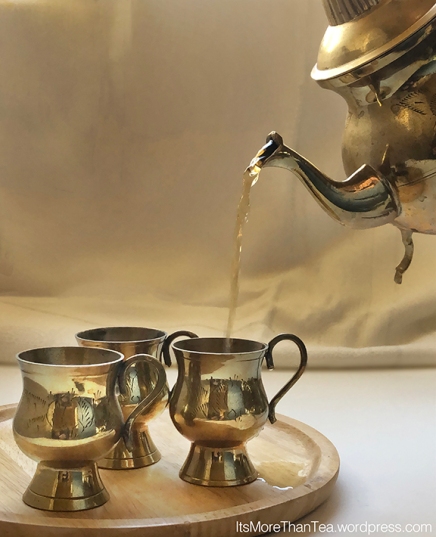As probably all of us have been discovering, staying at home brings some unforeseen minor inconveniences. We dismiss them as petty, especially in light of those who are currently working so hard to ensure we still have groceries and garbage pickup and emergency furnace repair and health care despite an overburdened system.
But for those of us confined to our homes, sometimes it’s the little things that irritate the most, perhaps because they remind us of how our lives have changed.
I pulled out this teapot that I was given a few months ago but never had the chance to research. And realized that I don’t know what metal it’s made of. And it hit me again that my metals-conservator daughter can’t just pop over and examine it for me!
But life continues, so I’m just taking this opportunity of being stuck at home to learn what I can on my own.

The Teapot
What I can say is that it’s a Moroccan teapot, and while those are often made of silver or stainless steel, this one is definitely neither of those metals. Its color suggests brass or bronze, which can look very similar:
- Brass—alloy of copper and zinc; very malleable
- Bronze—alloy, primarily copper, usually combined with tin, but can include various other metals; more expensive than brass due to its higher copper content; harder
Its interior, however, is silver in color, perhaps the “silver brass” that I saw mentioned on a blog post on Moroccan teapots but without an explanation of what, exactly, that is. To me it looks like the interior has been silver plated (somewhat visible in the photo below).
This teapot and its matching cups retain vestiges of the original cut marks, and the handle, spout, legs, and hinge for lid have been soldered on.

The pieces have been decoratively hand tooled, a technique that’s been used for millennia. Simple motifs evoke leaves and other natural forms, and the teapot legs form elliptic leaves with stems.
There are no maker’s marks on this set. Authentic Moroccan teapots are handmade in Fez, and although my pieces were clearly handmade, I can’t say where they were made.
And while I first assumed that the teapot’s legs were decorative—I have an antique porcelain teapot that also has legs—that’s not the case.
Safa, in Moroccan Zest, explains that to make traditional Moroccan tea, the tea and mint leaves are boiled for several minutes right in the teapot.
The pot, therefore, is set directly on the stove and must be able to withstand heat. And, the pot must be compatible with the stove. Legs allow a pot to stand directly over the flame of a gas stove. For induction or electric stovetops, the teapot must have a flat bottom instead.
The shape of the teapot’s graceful spout also facilitates a “high pour,” which means holding the pot high above the cup or glass as you pour the tea. This both cools and slightly froths the tea.

The spout does not have any kind of built-in filter. Instead, the opening—a single bored hole—from pot to spout is very small, which ought to keep the mint and gunpowder tea leaves inside the pot.
The shape of the pot’s handle also facilitates easy high pouring. The design of the entire pot meets the functionality required.
Possible Hazard of Metal Teapots
So how safe is a metal teapot?
Studies have been done, of course, because metal does leach into the hot tea and sometimes that can be dangerous, such as the occasional lead poisoning case (Petit et al. 2003).
The specific alloy of the metal—and the soldering of the spout to the body of the pot—impacts what and how much leaching occurs. A 2013 study found that brass pots contributed lead, along with nickel, copper, and zinc, to the tea, whereas stainless steel pots leached out cadmium. And the tea itself, Chinese gunpowder in this particular study, chipped in some manganese and aluminum!
However, another team had earlier found that although some metal teapots were very toxic, others were not toxic at all. Further, they found that the tea itself “reduced somewhat heavy metal toxicity due possibly to the complexing ability of tea” (Boularbah et al. 1999). Nice to know that that’s a possibility but I wouldn’t count on it!
Knowing all this, I’m going to enjoy my Moroccan teapot as a work of art rather than a functional pot—but that doesn’t preclude me from enjoying Moroccan mint tea.
The Tea
You can make your own Moroccan tea by combining China gunpowder green tea and mint leaves, either fresh or dried.

Or you can buy a blend such as TeaHaus’ Moroccan Mint (green tea and mint leaves) or the more intensely icy LeTouareg (green gunpowder and peppermint oil; shown here). In Morocco, sugar would also be added, but that’s to taste. I personally like a strong minty flavor, without any sweetener.

Traditionally, Moroccan mint tea is poured into beautiful highly decorated glasses, so I’m not sure why my teapot has six matching metal cups (intended for the souvenir market??). I think the glasses are much more appealing!

But no matter how you brew and serve it, Moroccan mint tea is quite lovely on a stay-at-home afternoon!
See related posts: (1) What Is Gunpowder Temple of Heaven Green Tea? and (2) Moroccan Mint Tea, which takes a closer look at mint.
Sources:
–Boularbah, A., et al., “Assessment of metal content and toxicity of leachates from teapots,” Science of the Total Environment 227(1):69–72. 2/16/99.
–Petit, D., et al., “Lead poisoning from metallic teapots traditionally used by North African populations,” J. Phys. IV France 107:1053. 2003.
–Petit, D., et al., “Trace element content in tea brewed in traditional metallic and stainless steel teapots,” Environmental Monitoring and Assessment 185:8957–66. 2013.
–Safa, “Finding the best Moroccan teapot,” Moroccan Zest, 11/14/18.
